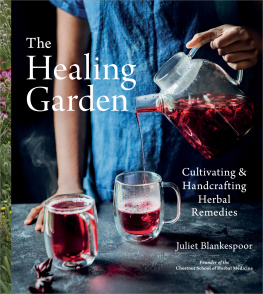Growing & Using Rosemary
Bertha Reppert
Introduction
What can you do with a simple sprig of rosemary?
Tuck it into a 6-pound roasting chicken.
Season a 7-pound beef roast.
Flavor an 8-pound leg of lamb.
Marinate a few leaves in your chicken salad for an exquisite flavor.
Pour boiling water over a few needlelike leaves for an exhilarating cup of tea to stimulate remembrance.
Boil the whole sprig and strain the aromatic water into your hot bath to relax tired nerves and muscles.
Place it between woolens to repel moths.
Toss it into the fireplace as fragrant incense.
Tuck it into a letter of condolence for remembrance.
The list goes on, for rosemary has always captured the hearts and minds and spirits of men and women.
Rosemary is one of the oldest recorded herbs in history. There are references to rosemary written in cuneiform on stone tablets from ancient Sumeria dating from the fifth millenium b.c. Every culture and civilization since then has contributed lore, legends, and additional uses for this versatile herb. We are the beneficiaries of this priceless knowledge.
Used as seasoning, for fragrance, medicinally, in cosmetics, for ornament, symbolically, and in magic, rosemary, the herb of remembrance, could well head the list of herbs beloved for use and for delight (the motto of The Herb Society of America, taken from Paradisi in Sole by John Parkinson).
Native to southern Europe, the Mediterranean region, and the Middle East, where it grows as wild as our daisies or goldenrod, rosemary is indispensable to the culinary and medicinal lore of that part of the world.
Through the ages, this evergreen aromatic herb has been quickly added to cuisine, pharmacy, and lore wherever it has found a new home. Always recognized as a powerful herb with mighty potential and great charm, rosemary has inspired so many uses over the years that they could easily fill a book.
Growing Rosemary
Rosmarinus officinalis grows best outdoors where winters are mild. Its name is from the Latin ros marinus, translated as dew of the sea, which tells us something of its cultivation demands. It adores the sandy, well-drained shores of the mighty Mediterranean, where it basks in full sun while enjoying misting by the dew of the sea.
For those of us who harbor pet rosemaries indoors every winter, certain requirements are the secret of growing rosemary houseplants successfully: coolness, sun, good drainage, and frequent misting.
I cannot emphasize enough the importance of these conditions. For those whose rosemary plants have perished from indoor container cultivation, give these essentials a try, especially the misting, and success will be yours. In fact, misting and humidity are so vital to rosemarys health and vigor, I recommend keeping a spray bottle handy at all times. It only takes a few seconds to mist a dozen plants (and people will benefit from the moisturized air as well).
Careful attention to watering is also vital to the well-being of a potted rosemary, indoors or out. Underwatering can be bad, but overwatering is a disaster. Your rosemary roots will rot, leaving you so quickly it will take your breath away. Rosemary can be unforgiving.
Proper drainage never permitting water to accumulate in its saucer and allowing the plant to dry out between waterings will prove to be a good precaution. Placing pots on a bed of pebbles in a large pan also works well. After the water drains off onto the stones, the evaporation of the water will give the rosemaries the moist humidity they require.
Warning: If you double-pot your rosemary using a decorative container, add drainage to the outer pot so the plant never sits in excess water. Monitor double-potted plants frequently.
When a sunny south, east, or west window is not available, try growing rosemary under horticultural grow-lights (actually any cool fluorescent fixture will work). This works surprisingly well and will brighten a dark corner to boot. Remember, rosemary requires at least six hours of sunlight every day to flourish. An unheated sunroom is ideal.
Any potted plant will eventually exhaust available soil nutrients. Monthly feeding with a good houseplant fertilizer is usually suggested. I like to alternate several different brands in small amounts applied frequently.
Occasionally we treat our rosemaries to a dose of Epsom salts. It kills bugs while also providing a nutritional element magnesium. Used in the ratio of 1 teaspoon per quart of tepid water, it is the secret ingredient that encourages sturdier stems and stronger fragrance.
Outdoors, rosemary will thrive in the garden, wallowing in the freedom to spread out and grow vigorously. In climates with moderate or warm winters, rosemary layers itself, especially on sun-drenched, well-drained banks, and has been called a weed. We feed our garden rosemary bonemeal, superphosphate, and a bit of lime every fall. These fertilizers can be made available to the plants as needed. Compost and mulch are excellent additions, useful to keep down weeds while gently feeding the plants. In very hot areas, mulch is crucial to help stabilize soil temperatures that can otherwise mount to 130F.
Rosemary is not reliably hardy north of Zone 7. In colder areas, light frosts signal the time when the plants should be put into pots to winter indoors. Rosemary withstands cold down to 28F, so I pot my plants up in September, allowing them time to adjust their roots to confinement before being brought indoors in mid-November.
On a sunny fall day, potting the plants is a pleasant task. I assemble fresh potting soil mixed with sand and compost; drainage materials (recycled packing peanuts are lightweight and available); pots, matched or assorted, of all sizes; and a pair of good, sharp pruning shears. Instead of crowding the roots, I clip them to fill the pot comfortably. A little judicious top pruning may also be necessary. I talk to them, water them well, then set them aside in light shade to settle comfortably into new homes.
Outside in their pots, rosemary plants cheerfully withstand quite cold nights, especially if wrapped in plastic. In turn, the misty cool mornings are just what they need to settle into their pots and fortify themselves against impending life indoors an environment frequently hot and dry with poor light.
On mild days in winter, I put my collection outside for a breath of fresh air. If weather reports are favorable, they can stay outside for several days, much to their liking. Moving the plants is a bit of a nuisance but well worth the effort. I can hear the grateful rosemaries whisper, Thank you.
Pests and Diseases
Insects and diseases are rare with house rosemaries and nonexistent with outdoor plants. My guess is that the abundance of piney, resinous oil in the leaves deters such problems. Red spiders, aphids, or whiteflies can be dealt with by using powdered soluble kelp, 1 tablespoon per gallon of water to water or spray your plants. Not only is kelp a natural pesticide, it also stimulates root growth and makes for a healthier plant. You can purchase kelp at a good nursery supply center or in gourmet food stores where it is sold to serve with sushi; or you can gather your own when on vacation at a beach.
Powdery mildew occurs when air circulation, indoors or outdoors, is poor. The mildew can be controlled with flowers of sulfur, available as a powder from a pharmacy. Use an old salt shaker to apply when necessary.
If your rosemaries perish during their stay indoors for whatever reason, do not despair. Gather up the dried leaves, save the precious wood, and replace your loss as quickly as possible. Although rosemaries rarely succumb under greenhouse conditions, I lose a few every year and have learned to accept the idiosyncrasies of my favorite herb. I simply treat them as annuals and hasten to buy another plant or two.







